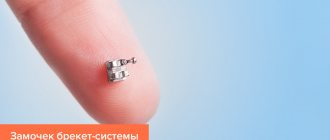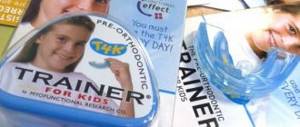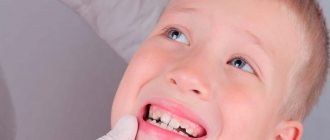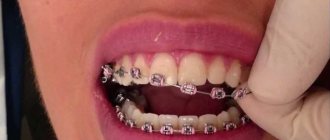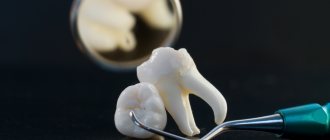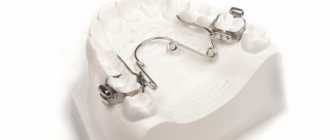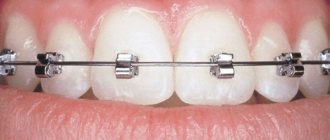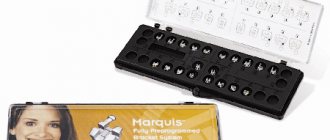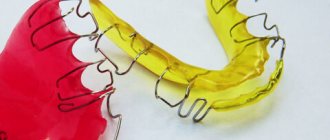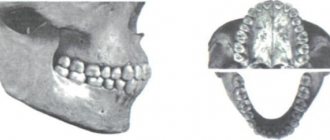What kind of device is this
A facial bow in orthopedics (dental prosthetics) is a unique measuring device that is fixed on the protrusions of the skull and on the dentition, and helps to establish the patient’s individual bite parameters. A dental facebow is required to know the relationship of the patient's jaws to the maxillofacial system as a whole. It also transfers the spatial position of the upper jaw and the axis of rotation of the lower jaw to the articulator. The upper dentition is oriented relative to the heads of the temporomandibular joints (TMJ) and the patient’s mouth opening axis – and these parameters are recorded.
What is the name of the facebow that is worn along with braces on the teeth? This is an orthodontic arch or mask, which is suitable, for example, for forced traction of the upper jaw. This is no longer a device for recording parameters, but a device that helps change the shape of the dental arch of the upper or lower jaw. There are orthodontic devices designed to correct the shape of two jaws at once. They are worn for several months, 4-14 hours a day, mainly during adolescence.
What is a facebow and how can it correct malocclusions?
In dental practice, there are two devices that are visually similar to each other - the orthopedic and orthodontic face bow. They are often confused, although the functions they perform differ significantly. An orthopedic face bow is a design designed to accurately “read” the occlusion (closing) of the jaws and, as a result, produce a functional, high-quality prosthesis that most closely matches the individual anatomical characteristics of the patient.
But an orthodontic facebow is a device for correcting abnormalities in jaw development and crowded dentition. We propose to talk further about it, its varieties, strengths and weaknesses.
Why use an arc - indications
Why is this design needed? A facial bow is necessary for the subsequent production of a comfortable prosthesis - complete and partial, removable and non-removable, incl. on implants. But, as a rule, these devices are used for extensive prosthetics, i.e. when the patient is missing a large number of teeth in the upper and/or lower jaw or all at once. Although in dentistry that offers patients truly high-quality prosthetics, the design can be used even for the manufacture of 1-2 crowns or a small bridge. The use of the device is often indicated in conjunction with an axiograph, which records the trajectory of the lower jaw. The examination takes only a few minutes.
Types of arcs
To remove a model of teeth, arches are used:
- portable (medium anatomical) with an ear type of fastening for the manufacture of removable dentures;
- axial (kinematic) for the manufacture of perfectly fitted prostheses.
Also in orthodontics, the following types of arches are used to limit mandibular movements:
- uts 3d facebow (used to transfer jaw features to the articulator);
- facebow sam (or adapter to non-adjustable articulators);
- Stratos arc (a type of universal articulator for dental occlusion).
Types of structures and their structure
In the classical sense, a facebow for an articulator is a complex metal structure. This includes the main frame - a crossbar or U-shaped curved plate. Stops or brackets are attached to the frame. The removable parts of the structure are a bite fork shaped like a dental arch, and a three-dimensional clamp with which the doctor attaches the fork to the rest of the device. The kit may contain either 1 reusable fork or several disposable ones, indicators (by which the dentist is guided in the process of aligning the axis).
PROSTHETICS WITH 6 OSSTEM IMPLANTS FROM RUB 200,000.
Complex implantation Osstem (South Korea) with delayed loading after 4-6 months.
Call now or request a call
There are 3 types of face bow designs - mechanical, electronic, digital. They have the following names and characteristics:
- portable or mid-anatomical facebow (mechanical): its installation occurs due to ear or joint supports, which are located approximately near the axis of rotation of the condyle of the temporomandibular joint. This device is most often used for prosthetics1 with complete or almost complete edentia - when all the teeth in a row are missing or there are few of them left,
- axial or kinematic (mechanical and electronic): a more accurate device that allows you to determine the individual (true) axis along which the temporomandibular joint rotates. Most often used in the manufacture of partial dentures,
- digital: the most modern variety that can record all true parameters with comfort and high speed. This device consists of a bite fork and a small sensor attached to it. Used for the manufacture of any prostheses.
There are still very few clinics in our country that have miniature digital face arcs at their disposal, because... This equipment costs much more than conventional mechanical equipment. In addition, a doctor must be able to work with such devices.
Advantages of using the device
The positive qualities of a facebow in dentistry are as follows:
- eliminating errors when modeling a bite on a prosthesis: previously, dental technicians received from the dentist only impressions of the jaws and a detailed description of the bite - and it was not always possible to create ideal dentures based only on these data,
- acceleration of prosthetics: since the patient does not need to come for frequent fittings, after which the prosthesis is sent for revision,
- manufacturing a comfortable, aesthetic and functional design,
- faster adaptation and restoration of diction after prosthetics,
- the chewing load is distributed more evenly along the row,
- extending the period of use of the prosthesis: because it is made in full accordance with the patient’s bite relationships, which reduces the risk of breakages - cracks, chipping or abrasion of artificial teeth,
- the smile looks harmonious: the teeth are aligned relative to the facial features (bridge of the nose, nose, chin).
Don't know what type of prosthetics to choose?
We will help in the selection, advise where to read more information and compare types of prosthetics.
Consultation with an orthopedic doctor in Moscow clinics is free! Call now or request a call
Working hours: from 9:00 to 21:00 - seven days a week
Advantages and disadvantages
Any medical device is designed to solve a specific problem and has a number of advantages. Dental structures also have disadvantages, which the doctor must inform the patient about before starting treatment.
Advantages of using an articulator with a facebow:
- Chewing function is completely restored.
- The ability to check and straighten the inclination of the teeth relative to the movement in the joint in the incisal (lateral) direction.
- Ensuring harmonious jaw development in adolescents and children.
- Prostheses created using articulator data are ideal for a person and are aesthetically pleasing.
- The number of trips to the dental clinic to install a prosthesis is reduced.
- The load on the dentition is distributed rationally. This extends the life of the prosthesis.
- Ensuring the aesthetically correct position of the anterior dentition relative to the lips, nose and eyes.
- The facebow articulator is comfortable to wear. Therefore, the patient quickly gets used to it.
- No contraindications for use.
Dental articulator with facebow
The face arc design has the following disadvantages:
- The system can provoke problems with eating, diction, and sleep.
- An unaesthetic appearance causes psychological discomfort.
- In case of complex occlusion pathologies, the arch turns out to be ineffective.
- Sharp parts of the device can damage the mucous membrane, causing inflammation, swelling, and bleeding of the gums.
How to work with the structure
How to use a facebow? Installation or application is carried out in three ways. The first two overlay algorithms are used for average anatomical devices, the third – for kinematic ones. Let's consider them further.
The first method of installing a mid-anatomical device
The generally accepted steps for installing a mid-anatomical facebow are as follows:
- The bite fork is tried on the upper row of teeth and removed,
- The bite fork with the applied impression material is easily pressed against the upper teeth or toothless gums: the fork is held from below with fingers or cotton rolls,
- the device is fixed at several points using stops: in the external auditory canals, as well as a nasal stop on the bridge of the nose,
- the fork is attached to the main frame using a three-dimensional clamp,
- the device is adjusted and records the position of the upper jaw and the axis of rotation of the lower jaw,
- the fork is removed from the facebow along with the mount and transferred to the plaster table and then to the articulator. After that, a plaster model of the upper jaw is worked out in the articulator, taking into account the parameters obtained when applying the arch.
It is important that for high-quality reading of parameters, the patient must be relaxed and his shoulders should not be tense. Some devices are more convenient to install when the patient is in a lying position, and registration occurs in a sitting position.
“When I went to get prosthetic teeth, I thought that impressions would be taken and that would be it. They also took facial parameters with a special device to make the prosthesis better. This is a frame that is attached to the ears, and a small spatula for impressions is attached to the teeth. Then you hold the frame yourself on the sides, and the prosthetist stands opposite and tells you which hand to raise so that the alignment matches.”
Svetlana Sh., review from the website stomatology.rf
The second method of installing a mid-anatomical device
The second technique, in general, repeats the first, but with one difference. The device is attached here using joint supports (not ear rests). That is, not to the ears, but next to them on the face - approximately at the center of rotation of the TMJ condyle. In this case, the measurement error is about 2 mm.
The third method is for a kinematic arc
When using a kinematic device, the fork is initially attached not to the upper, but to the lower jaw. Next, the patient begins to move his jaw in different directions - back, forward, closing and opening his mouth. At this time, the joint stops begin to move, and the dentist marks the resulting points - these are the central positions of the heads in the joints. After this, the fork is transferred to the upper jaw and the parameters are continued to be taken using the first method (described above).
How much does the examination cost?
The cost of taking bite parameters using a facebow is difficult to separate from the total price of prosthetics, because it is not usually considered separately. After all, not only this, but also other devices are used for prosthetics: myographs, axiographs, articulators, etc. It is also necessary to take impressions - classical or digital - and take photographs of the face and X-rays. Without this, it is simply impossible to simulate an ideal smile and get a prosthesis that will feel like your own teeth in your mouth. If we take into account a comprehensive examination and registration of all parameters before prosthetics, then its cost can be 3000 rubles and 30 thousand - depending on the volume of the clinic’s capacities involved.
Your questions and answers
QUESTION Hello, I wore a facebow in school with braces. How does it differ from the one needed for dentures? It’s just that my aunt recently went to the orthopedist, and they measured her face arc, will she really have to wear it too, like me?! Anastasia
ANSWER Hello, Anastasia. These are completely different devices, they have one thing in common - they are fixed on the face. Let's now understand the differences. So, a facebow for braces is an additional device that is attached to the back of the head, neck, or forehead and chin. The orthodontic arch has special fasteners that can be hooked onto the braces - this applies additional pressure and sets the direction of teeth alignment. Now to what an orthopedic arch is. This is already a kind of template that takes the parameters of the position of the upper jaw and the axes of the joints of the lower jaw. An orthopedic arch is used to ensure that the prosthesis fits the patient perfectly, and is not made “by eye.” There is no need to wear such an arch all the time (it is tried on only once), unlike an orthodontic mask - it has to be worn for months to achieve the effect.
1Dapprich Y., Oidtmann E. Prosthetics for complete edentia, 2007.
Author: Sambuev B. S. (Thank you for your help in writing the article and the information provided)
Disadvantages of the device
This design has few disadvantages, especially if you understand its benefits and effectiveness even in the most complex clinical cases. These include discomfort during use - in some patients it occurs throughout the entire treatment, because the device itself is quite massive and it takes time to get used to it. It can cause problems with diction and articulation, and chafing of the mucous membranes.
Among the disadvantages, one can also note individual intolerance by some patients and the possibility of allergic reactions to the metal from which the structure is made.
In addition to individual intolerance to the material, there is also a risk of injury to the oral cavity during sleep: the fact is that in some clinical situations it is necessary to wear the device around the clock, so the patient has to sleep in it. And because of the protruding part of the arch, sleeping is only allowed on the back, but during sleep this process can be quite difficult to control, especially for children. And since the central loops of the structure are loosely attached to the rings of the intraoral part, when sleeping on the side, the fixing element can come off and injure soft tissues.
Important! A facebow with a neck fastening is considered the safest for wearing and sleeping, however, in order to minimize the risk of injury from its use, doctors advise using special devices or safety bars at night.
